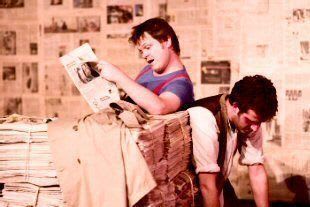British writers are often remarkably straightforward compared with some of the work we see in translation. I don't mean that they don't use allegory and symbolism (there are many echoes in this play of Pinter's Birthday Party) but most of what we see, in mainstream theatre at least, is centred on naturalistic situations. Is it because they don't have to disguise what they are saying as, for instance, in the Eastern bloc until the Prague Spring (and frequently afterwards) a production or a writer would present one thing when they were really talking about something politically dangerous to openly speak about.
Though Siamese Twins was first produced in 1967, before the worst excesses of the Argentinean Dirty War and the abduction and often murder of the "Disappeared", for long periods the country had had authoritarian regimes. One cannot help wondering whether the first audiences for this play would have identified the menacing figures who appear in it with particular political or public faces. On one hand this play is an outcry and a prescient warning about this the misuse of authority and fearful acquiescence before it and on the other a picture of the exploitation, cruelty and even torture that even partners or siblings can inflict upon each other.
It is indeed about a pair of twins. One of them seems not excessively bright upstairs but devious and exploitive and on medication, the other gentle and caring. There is a mutual dependency, however unbalanced, and at times they talk as though they are real Siamese twins, actually joined to each other and they physically become so in the exercise routines they do together at the insistence of Lorenzo, the 'bad' one, Yet, when the play begins, they are very separated. Lorenzo has locked himself inside their home refusing to let his brother Ignacio in, despite his pleas, so that he gets beaten up outside, collapsing from his injuries.
In effect this is a long opening monologue, beautifully sustained by Bob Witcomb as Lorenzo, that extends over the two opening scenes. It is not the actor's fault that it goes on long after it has made its point and in this way succeeds in giving the spectator something of the painful frustration of Fred Gray's still unseen Ignacio. The two performers are an excellent pairing. I would expect real Siamese twins to be identical; these two are very different in appearance as well as in behaviour. You could read them not as individuals but as two aspects, two potentials, in every one of us.
The pair from the police or security forces who arrest Ignacio are at first comically grotesque: Jay Worthy is a bent and angular Smiley Man and Emile Clarke like a wing-flapping crow, cawing incomprehensibly. They could be characters out of Ben Jonson's Volpone. Later, when they are making others carry out their dirty work, the playwright cleverly has them appearing as quite ordinary people; how easily people can hide their sinister business.
Grahame Edwards gives a no holds barred performance in a cameo role as an old man trying to keep his feet out of a running sewer but refusing to lift his head and see the world around him, the character a rather arbitrary introduction to make its point but an opportunity for bravura playing.
Directors Mara Lockowandt and Jorge Perez Falconi have drawn committed performances from a strong cast of newcomers and experienced actors, moving smoothly from naturalism to stylization. There is a particularly effective fight that switches intermittently from slo-mo to quick fire matched with Kostas Panafiotou's specially composed music which also bridges the transitions from scene to scene. His sources seem eclectic, did I catch one passage, appropriately for this venue, based on a Cretan folk song, a reminder that Greece is one of those places with a history of right wing oppression?
Designer Sylwia Dobkowska has set the play in a world of newspaper. Nor only are the set walls plastered with it but all the furniture is made from piled bundles. Should we believe what we read? Who controls the media? As some of the dialogue reminds us, the Kennedy assassination gets reported but what about the daily assassinations around us? Perhaps the newspaper idea is part of the original script not just the idea of the designer, but she has certainly made it work effectively, making it possible to dig a newspaper grave.
A forceful play, it is lightened by a bitter humour, its action holding our attention through the actors' playing and its ideas resonating afterwards.
"Siamese Twins" runs at Theatro Technis until 25th September 2011
